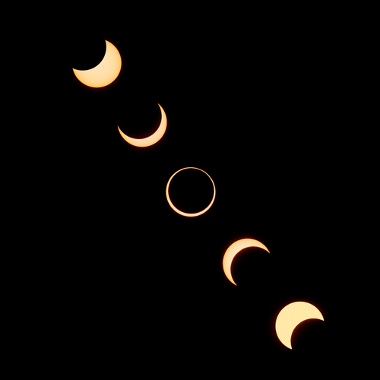One solar eclipse is an astronomical phenomenon that occurs whenever the Moon is positioned between the planet Earth and the Sun, forming a shadow that covers a small swath of the Earth's surface, causing, during the eclipse, this area is dark for a limited time of day.
During the solar eclipse, two well-defined areas are projected onto the Earth's surface: the umbra and the penumbra. Check out the schematic model below:

Explanatory scheme of a solar eclipse
The umbral area, that is, the area in which the umbra appears, is where the eclipse is fully manifested, where it is totally dark during the eclipse. The penumbral area is the one where the eclipse occurs only partially, with a brief shadow.
Hardly two solar eclipses with identical characteristics occur, as their occurrence depends on the degree of inclination of the lunar orbit and also of the distance of the Earth from the Moon and from the Sun during the phenomenon astronomical. Thus, depending on this distance, a shadow is not formed entirely, but only a "point black", which would be the Moon, in smaller apparent size, passing in front of the Sun before his vision in the Earth.
Therefore, when the Moon is close to Earth and the Earth is far from the Sun, a complete shadow is formed, and when the Moon is further away from Earth, an incomplete shadow is formed. Thus, solar eclipses are classified into:
Total solar eclipse: when all the sunlight is hidden by the moon
Partial solar eclipse: when only part of the solar luminosity is hidden by the lunar disk.
Ring eclipse: when the size of the Moon is not enough to cover the entire area of the Sun, forming a “ring” around the Earth's natural satellite.
Hybrid Eclipse: when the eclipse is total in some points of view and annular in others, due to the degree of inclination of the lunar orbit.
The phenomenon of solar eclipse can only happen during the new Moon, as it is only in this phase that the Moon is between the Earth and the Sun. In addition, the Moon needs to cross the Earth's orbital plane, which occurs only twice a year because of the inclination of its displacement in relation to the Earth's axis, which is 5 degrees. If this inclination did not exist, whenever there was a new Moon there would be a solar eclipse.
Although they need a coincidence between the moon phase nova and certain nodal and orbital positions, there is a cyclical period for the occurrence of the eclipses, so that they occur again with the same characteristics and order as the previous period. This cycle is about 18 years and 11 days and is called Saros Period. Each year, depending on astronomical conditions, it is possible to have at least two solar eclipses and at most five.

Sequence of an annular solar eclipse
By Me. Rodolfo Alves Pena
Source: Brazil School - https://brasilescola.uol.com.br/geografia/eclipse-solar.htm


